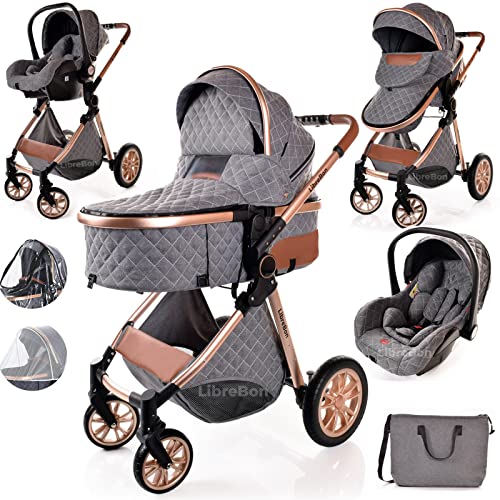The Comprehensive Guide to Choosing the Right Pram for Newborns
The arrival of a newborn brings both tremendous delight and a selection of decisions that moms and dads must browse. Among the essential purchases is choosing the best pram, which not just guarantees the baby's safety however likewise offers convenience for parents. This guide intends to supply an extensive look into choosing the suitable pram for newborns, talking about various types, functions, safety factors to consider, and maintenance suggestions.
Comprehending the Types of Prams
Prams differ commonly in design and performance, which can be frustrating for brand-new parents. Here's a breakdown of the most typical kinds of prams offered in the market:
| Type of Pram | Description | Pros | Cons |
|---|---|---|---|
| Standard Prams | Designed for infants, these prams generally have a deep bassinet. | Comfy for newborns, Safe for sleeping. | Bulky and heavy, Hard to navigate in tight spaces. |
| Travel Systems | A combination of a safety seat and a stroller, enabling easy transition in between vehicle and stroller. | Versatile and convenient, Cost-effective. | May be heavier than standalone strollers, Not all parts are suitable for newborns. |
| Lightweight Strollers | Compact and simple to steer, these are perfect for moms and dads on the go. | Portable and simple to use, Generally more economical. | Less cushioning, May not recline completely for newborns. |
| Convertible Strollers | Strollers that can adapt from a carrycot for newborns to a young child stroller. | Multi-functional and lasting, Adjustable setups. | Can be pricey, May need more upkeep. |
| All-Terrain Strollers | Built for rough surfaces, these strollers generally include bigger wheels. | Resilient for outside usage, Stable on numerous surfaces. | Much heavier and bulkier, Can be hard to guide indoors. |
Key Features to Consider
When selecting a pram for newborns, numerous functions can substantially impact use and safety. Here are vital functions to bear in mind:
- Safety Harnesses: Look for a pram that consists of a five-point safety belt to ensure the baby stays safe and secure while in transit.
- Reclining Seat: A totally reclining seat permits newborns to lie flat, which is necessary for their spine and respiratory health.
- Suspension System: A good suspension system offers a smoother ride, vital for the delicate bodies of newborns.
- Brake System: Ensure the pram has a dependable brake system to avoid accidents. Hand brakes or foot brakes can be effective alternatives.
- Storage Space: Consider a pram with adequate storage area for diaper bags, shopping, or other basics.
- Weight and Foldability: Choosing a light-weight choice that folds easily is vital for benefit, particularly for public transport.
Security Considerations
Prioritizing safety is vital when it comes to prams for newborns. Here are vital safety ideas to ensure the well-being of your baby:
- Check for Stability: Make sure the pram stays steady when fixed. A wide base can provide increased stability.
- Prevent Overloading: Only location products suggested by the maker in the storage basket; excess weight can lead to tipping.
- Routine Maintenance: Inspect the wheels, brakes, and harness systems consistently to guarantee they work appropriately.
- Buckle Up: Always utilize the safety harness, even for quick trips, to avoid the baby from slipping or falling out.
- View for Age Recommendations: Follow the manufacturer's guidelines relating to weight limits and age suggestions for safety.
Upkeep Tips
Taking care of a pram ensures its durability and safety for your newborn. Here are essential upkeep tips:
- Regular Cleaning: Wipe down the pram frame and wash fabrics according to maker directions to keep it hygienic.
- Check the Wheels: Check wheels for damage and tidy them regularly to prevent blocked motion.
- Check Folding Mechanism: Ensure the folding mechanism runs smoothly without sticking or jamming.
- Lube Moving Parts: Apply the appropriate lubricant to moving parts to make sure peaceful and smooth operation.
- Store Properly: When not in usage, store the pram in a dry area to prevent rust and maintain material stability.
Frequently Asked Questions (FAQs)
1. For how long can a baby be in a pram?
For newborns, it is usually advised to limit uninterrupted time in a pram to about 1-2 hours to avoid concerns with advancement and circulation.
2. Which pram is best for a newborn?
The very best pram for a newborn is one that offers a totally flat recline, has a great safety harness, and meets existing security requirements. Numerous moms and dads choose travel systems for their adaptability.
3. Can I use a stroller without a safety seat for a newborn?
It's recommended to utilize a stroller with a flat or near-flat recline for newborns. Some strollers are only ideal from six months and up, so check the manufacturer's assistance.
4. When should I change from a pram to a stroller?
You can move from a pram to a stroller when your baby can stay up independently, typically around 6 months, however this can vary. It's constantly best to seek advice from the private pram or stroller guidelines.
5. What is the very best method to clean my pram?
Constantly describe the maker's guidelines, however usually, you can clean up fabrics with moderate soap and water and wipe down tough surface areas with disinfectant wipes.
Choosing the right pram for a newborn is a significant choice that affects both the baby's convenience and the parent's lifestyle. By understanding the types of prams offered, key functions to consider, safety strategies, and upkeep pointers, moms and dads can make educated choices that boost their household's mobility and guarantee the security of their children. Prams Online in research now settles in the long run for pleasurable getaways and valued memories.

